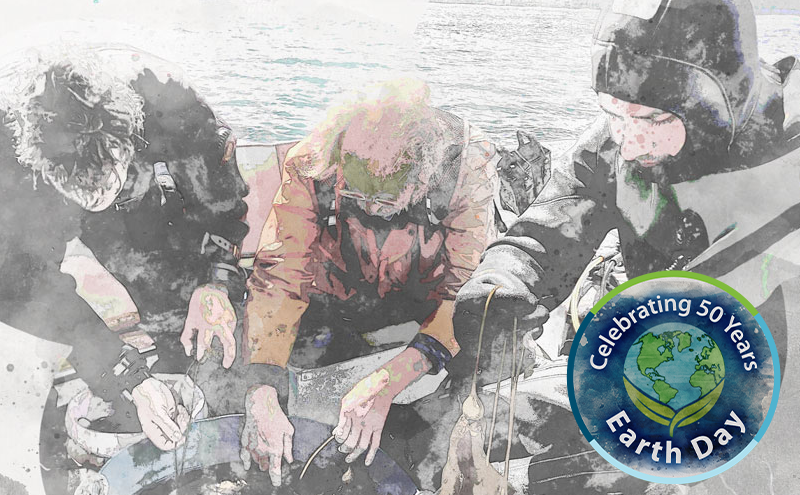
Read a detailed history of environmental milestones at the Port in the last 50 years.
1970
First Earth Day celebrated. More
1973
SEA Airport reduced electricity consumption by 15 percent. This was shortly after Seattle introduced the Kill-a-Watt campaign on July 17, 1973.
1975
Port commits to analyzing and evaluating the potential environmental effects due to port development, mitigation of environmental impacts, and citizen participation in planning for major new developments.
1976
SEA Airport was the first airport in the United States to hire a full-time biologist to address problems posed by birds that live and migrate in the areas surrounding the airport. More
1977
Public review of large-scale port development actions, including analysis of potential environmental/community effects due to proposed marine cargo development.
1985
- Established Neighbors Advisory Committee that has met monthly since 1985, providing transparent community/redevelopment review and decision-making. More
- Developed a comprehensive strategy that made public shoreline access part of the Port’s business mission, resulting in public shoreline access at Shilshole Bay Marina, Fishermen's Terminal, the Terminal 91 bike path, and others. Included a strong public access plan for collaboration with citizens and the City.
1986
First habitat restoration project at Terminal 91 for aquatic habitat compensatory measures.

1988
First formalized collaboration with a Treaty tribe with the Muckleshoot Tribe for a voluntary fish and wildlife enhancement project at Terminal 106.
1993
SEA Airport launched the Waste Minimization Recycling program. More
1995
Acquired and cleaned up over 15 industrial properties including both state and federal superfund sites.
1996
First federal grant award received for fish and wildlife restoration in Elliott Bay and the Duwamish Waterway.
1998
Largest fish and wildlife habitat restoration in Duwamish Waterway at Turning Basin Number 3.

2000
- Redeveloped Terminal 5 to provide more than 5.8 acres of public shoreline access — the largest waterfront park in the past 25 years.
- Completed environmental cleanup at the Harbor Island Superfund site, creating public shoreline access and an improved pedestrian/bicycle corridor.
2001
Shilshole Bay Marina received a 5-star ranking through King County’s EnviroStars program. More
2003
Port of Seattle receives its first Salmon-Safe Certification, the first organization in WA to gain this recognition. More
2004
Port of Seattle and Cruise Lines International Association North West and Canada (CLIA-NWC) signed a voluntary agreement that bans wastewater discharges to Washington state waters from all cruise ships, except for ships with advanced wastewater treatment systems (AWTS). Provides Port access to inspect the wastewater treatment systems on each vessel and requires cruise lines to sample and monitor wastewater discharges from their ships. More
2005
- Port conducts the Puget Sound Maritime Air Emissions Inventory, the first emissions inventory in the country to include a detailed activity-based inventory of greenhouse gases, diesel particulate matter, and several other pollutants for maritime-related sources. More
- Port created (with Tacoma, and Vancouver BC) the Northwest Ports Clean Air Strategy, the first regional/international agreement among Ports to improve air quality and reduce GHG emissions. It has continued for 15 years and is being updated in 2020. More
- Becomes the first port in the world to provide shore power connections at two home port cruise terminals. More

2006
- SEA was one of the first airports in the nation to conduct a comprehensive greenhouse gas emissions inventory. The Port set airport greenhouse gas reduction targets for 15 percent by 2020, 50 percent by 2030 and to be carbon neutral by 2050. More
- The airport begins a food donation program to give unused food items from airport restaurants to the Des Moines Food Bank. The program is still operating and donated (39,000 meals in 2019) to combat food insecurity in neighboring communities. More
- SEA’s underground fuel hydrant system reduces the number of diesel-powered trucks and improves safety on the airfield. Fuel is delivered to each gate by underground pipes.
2007
SEA Airport installed an Industrial Wastewater System and Stormwater Management system to treat stormwater runoff potentially contaminated during aircraft fueling, deicing, or maintenance before it is discharged to the Puget Sound. It’s reduced the amount of glycol discharged from the airport to Puget Sound by 98% since installation. More

2008
Design standards for architectural, signage, casework, mechanical and electrical projects were updated to include environmental and sustainability performance measures. Many construction projects are designed and built using Leadership in Energy and Environmental Design (LEED) and other sustainable building performance measures.
SEA won the 2008 Environmental Achievement Award from Airports Council International — North America (ACI-NA) in the Mitigation Category to recognize SEA’s Comprehensive Stormwater Management Program (CSMP) addressing stormwater issues for the airport's multi-year expansion project.
2009
- Developed comprehensive habitat restoration plan for the entire Duwamish Waterway to support salmon recovery.
- SEA took first place among airports in North America in the Best “Green” Concessions Practice awards from Airports Council International-North America (ACI-NA) Concessions.
- The Port is a founding member of The Climate Registry and committed to reporting emission levels every year starting in 2009.
2010
Port adopted Century Agenda goals with strong environmental goals. Including being the Greenest Port in North America. More
2011
Implemented an innovative use of oyster shells in stormwater treatment to remove heavy metals like copper and zinc.
2012
SEA Airport opened the Consolidated Rental Car Facility that achieved Silver level under the U.S. Green Building Council's LEED program. More
2013
- Joined forces with local nonprofit The Common Acre to turn unused green spaces on the south end of SEA Airport into a native pollinator habitat and produce a breed of bees better suited for survival in the future. By 2020, the pollinator program includes more than 20 hives that are home to 500,000 bees. More
- Became the first Port on the West Coast to receive Green Marine Certification. More

2014
- SEA became the first North American airport to attain carbon certification by Airports Council International, for managing and reducing carbon dioxide (CO2) emissions,and has maintained this certification since.
- SEA introduced centralized pre-conditioned air and ground power allows aircraft to hook up to cooled or heated air at SEA gates. This system allows aircraft to shutdown auxiliary power units, which emit particulates and carbon dioxide (CO2) and cost the airlines fuel to operate. When fully utilized, the pre-conditioned air system reduces greenhouse gas emissions by more than 69,000 metric tons per year.
- SEA installed over 300 charging stations on the airfield to encourage airlines and baggage companies to convert their ground service equipment (baggage tugs, ramps, and pushback vehicles) from fossil fuel to electric. This currently saves over 5,000 tons of greenhouse gas emissions annually and is projected to save 10,000 tons when implemented airport-wide. More
- Seattle became the first port in the country to create its own stormwater utility, allowing the Port to manage critical stormwater infrastructure to improve water quality and protect Puget Sound.
2015
SEA Airport recycled or composted 50 percent of its terminal and landside waste. The 2020 goals are 60% waste diversion in the terminal and 15% waste diversion on the airfield. More
2016
- In 2016, the Port partnered with Boeing and Alaska Airlines to investigate the best locations to store and blend sustainable aviation fuel (SAF) into the airport’s fueling systems. The Port sets a goal to power every flight fueled at SEA Airport with at least a 10 percent blend of sustainable aviation fuel by 2028. More
- SEA Airport earned Industrial Standards Salmon Certification that recognizes Port efforts applying Low Impact Development stormwater management techniques, potable water conservation efforts, habitat protection and restoration program, invasive weed program, and ecological projects such as Bee Pollination Habitat and Community Planting Project.
2017
- The Port Commission adopted strong greenhouse gas reduction goals for 2030 and 2050 in alignment with the Paris Climate Agreement. More
- Solar panels were installed on the roof of the net sheds at Fishermen’s Terminal as a pilot project to prepare for 2019 solar panel installations at Pier 69 headquarters. More
2018
Implemented the Blue Carbon project at Smith Cove, to improve habitat, reduce ocean acidification, and capture carbon using native oysters, kelp, and eelgrass. More

2019
- The Port has long focused on operational carbon, but SEA is now incorporating embodied carbon — the emissions generated when building materials are manufactured and transported to the construction site — to transform how we invest and build infrastructure. The Port announced a collaboration to develop the Embodied Carbon in Construction Calculator (EC3) tool that enables the building industry to measure, compare, and reduce embodied carbon emissions from construction materials. More
- The Sustainable Airport Master Plan, the blueprint for changes at SEA Airport, will meet future passenger and cargo demand while protecting the environment. More
- The Port created, restored, or enhanced 177 acres of wetlands and buffers near SEA Airport, including planting approximately 350,000 native trees and shrubs.
- Port Commission adopts Resolution 3767, the Duwamish Valley Community Benefits Commitment, a policy formalizing the Port's commitment to work with the Duwamish Valley community in providing greater opportunities to near-Port neighborhoods that are disproportionately impacted by environmental justice issues. More
- Debuted the Late Night Noise Limitation Program, a voluntary program to reduce late night noise at SEA Airport by encouraging air carriers to fly during less noise-sensitive hours or transition to quieter aircraft. More
- To encourage the use of environmentally friendly vehicles, SEA offers 54 charging stations for electric cars in the airport garage. Two fast charging electric vehicle (EV) stations were added to the cell phone lot to serve up to four EVs at a time. More
SEA’s waste reduction and recycling programs reduce airport waste and increase diversion from landfill to address climate change.
2019 highlights:
- Waste Diverted from Landfill: Terminal – 44% (3,700 tons), Airfield – 9% (210 tons), Capital Construction Projects – 98% (104,000 tons)
- Recycled 2,000 tons of mixed paper, cardboard, metals, glass, plastics, and non-capital construction debris
- Composted 1,400 tons of organic waste including food scraps, packaging, green waste, and wooden pallets
- Recycled 18,900 gallons of used cooking oil into bio-diesel fuel
- Donated 750 meals per week (39,000 meals annually) to combat food insecurity in neighboring communities through partnership with a local food bank
- Recycled 40,000 lbs. of electronics
- Prevented generation of 119 tons of other waste materials
2020
- Construction of 13 acres of habitat at T117 is the largest habitat restoration in the lower Duwamish and achieves 35% of the Port’s Century Agenda goal for habitat restoration. More
- Commission approves a 10-year supply contract for Renewable Natural Gas a low-carbon natural gas alternative typically produced from landfill waste. SEA is the first airport in the country to utilize RNG to heat 55% of the airport terminal and power 100% of its bus fleet. The Port will reach its 2030 goal to reduce carbon emissions by 50% almost a decade ahead of schedule. More
2021
The North Satellite modernization project will be the third LEED Silver-certified building at the airport. The environmentally- friendly facility — using sustainable design, mitigating construction impacts, and operating the building with energy savings — is designed to maximize the health and productivity of travelers and staff, use fewer resources, reduce waste and negative environmental impacts, and decrease life cycle costs to operate the building. More
2028
SEA Airport’s goal is to power every flight fueled at the airport with sustainable aviation fuel by 2028. More
2030
In 2006, the Port set airport greenhouse gas reduction targets for 50 percent by 2030.
2050
In 2006, the Port set airport greenhouse gas reduction targets for 15 percent by 2030 and to be carbon neutral by 2050.






